Saturday, April 22, is Earth Day, an annual global event to support environmental protection. Here are some excellent recent children's books that bring kids into nature--both close to home and far away--and show them the world in need of saving.
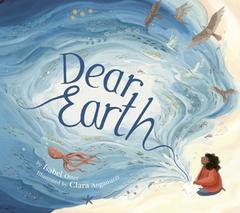 The beauty and marvels of the planet take center stage in the passionate picture book love letter Dear Earth by Isabel Otter (Tiger Tales, $18.99, ages 3-7). Accompanied by Clara Anganuzzi's dramatic illustrations, the missive makes for a persuasive argument in favor of conservation, and a delightful way to introduce these ideas to a young audience.
The beauty and marvels of the planet take center stage in the passionate picture book love letter Dear Earth by Isabel Otter (Tiger Tales, $18.99, ages 3-7). Accompanied by Clara Anganuzzi's dramatic illustrations, the missive makes for a persuasive argument in favor of conservation, and a delightful way to introduce these ideas to a young audience.
Otter's child protagonist, Tessa, has the same wild hair, light-brown complexion and rounded figure as her grandpa, who "had been an explorer once." Tessa, inspired by Grandpa's adventures, writes a letter telling the planet about all the miraculous sights she plans to see, and all the exciting experiences she intends to savor. The letter takes the audience through different biomes portrayed in dazzling colors by Anganuzzi's inviting and beguiling art. Tessa concludes her letter by acknowledging the delicate nature of Earth. Comprehensive, accessible back matter offers young people ways to provide assistance, as well as a template so they can write a letter of their own. Otter's charming picture book shows readers the vast and awe-inspiring planet while reminding them it's up to everyone to keep it safe and habitable.
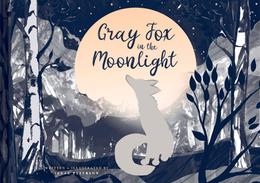 While Isaac Peterson creates the illustrations for Gray Fox in the Moonlight (The Collective Book Studio, $17.95, ages 2-8) almost entirely with grays and purples shot through with white, the variation among the images, coupled with the austere poetry in his every line of text, present a multifaceted and sumptuous nocturnal world.
While Isaac Peterson creates the illustrations for Gray Fox in the Moonlight (The Collective Book Studio, $17.95, ages 2-8) almost entirely with grays and purples shot through with white, the variation among the images, coupled with the austere poetry in his every line of text, present a multifaceted and sumptuous nocturnal world.
Peterson takes readers through a typical night in the life of the titular animal. "Gray Fox/ walks/ so lightly/ through the woods," the book begins. Soon the moon appears behind some trees, a pale orange orb seemingly "caught/ in the/ branches" and patterned with leaves. The moon and stars light Gray Fox's way as she approaches a river and examines her reflection. Moonlight also helps her follow a twisty path back to her den, "where/ her kits/ are/ dreaming." Gray Fox curls around them, moonlight-kissed feathery-leaved plants standing sentry. Gray Fox in the Moonlight is a book tied to no era, which perfectly suits a timeless hymn to the natural world and to parents' love for their children.
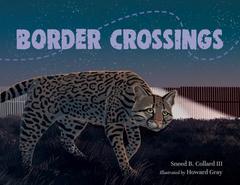 Author Sneed B. Collard III and illustrator Howard Gray present with conviction and a keen reverence for biodiversity the threat to animals and plants posed by the U.S./Mexico border wall in Border Crossings (Charlesbridge, $17.99, ages 6-9).
Author Sneed B. Collard III and illustrator Howard Gray present with conviction and a keen reverence for biodiversity the threat to animals and plants posed by the U.S./Mexico border wall in Border Crossings (Charlesbridge, $17.99, ages 6-9).
The border wall runs nearly 2,000 miles between the United States and Mexico, threatening the survival of creatures portrayed by Gray, including pronghorn, javelinas, and pygmy-owls. Collard refers to the wall as an "ugly scar," and Gray, who precisely captures the flora and fauna of the border lands, depicts in several spreads the wall's jagged edges interrupting sky and land. The book closes with a glossary, tips for further reading, and an author's note that provides more details, stressing the only way to protect the region and its treasures: "by letting others know that we care."
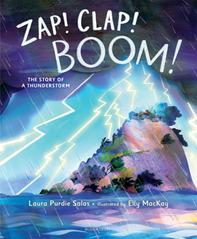 Bam! Science collides with poetry in Zap! Clap! Boom! (Bloomsbury Children's Books, $18.99, ages 3-6), in which Laura Purdie Salas's pit-a-pat rhymes match the tempo of a rain shower, and Elly MacKay's art rivals the drama of a real atmospheric disturbance. At first, three kids haven't a care as they kick a ball outside their home: "Sunny day sits warm and dry./ No wind,/ no rain,/ no stormy sky." The rhymes proceed, and the trio plays until they notice the clouds. Before long it's "ZAP! CLAP! BOOM!" The kids make a run for it, but too late! "Swollen clouds begin to drain,/ spilling/ splashing,/ chilling/ rain."
Bam! Science collides with poetry in Zap! Clap! Boom! (Bloomsbury Children's Books, $18.99, ages 3-6), in which Laura Purdie Salas's pit-a-pat rhymes match the tempo of a rain shower, and Elly MacKay's art rivals the drama of a real atmospheric disturbance. At first, three kids haven't a care as they kick a ball outside their home: "Sunny day sits warm and dry./ No wind,/ no rain,/ no stormy sky." The rhymes proceed, and the trio plays until they notice the clouds. Before long it's "ZAP! CLAP! BOOM!" The kids make a run for it, but too late! "Swollen clouds begin to drain,/ spilling/ splashing,/ chilling/ rain."
As the weather intensifies, so do the book's language and art. Salas imbues the stormy scene with a Halloweeny menace; MacKay uses bruise-like purples and blues to capture nature at its fiercest. MacKay builds texturally enticing tableaux that readers will want to reach out and touch... except, perhaps, when the storm is meanest. Then readers may wish they could be with the three kids enjoying the natural world through a window.
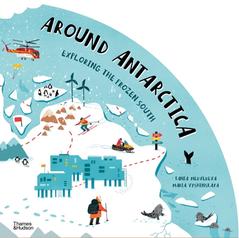 Author Tania Medvedeva and artist Maria Vyshinskaya's wonderfully informative, beautifully designed long-form picture book Around Antarctica: Exploring the Frozen South (Thames & Hudson, $27.95, ages 7-10) follows Tom, a "top-notch journalist," as he joins an expedition to visit a research station in Antarctica. A trip to this "mysterious frozen continent" requires warm clothes, but no visa because "Antarctica doesn't belong to any country." There's no military presence or mining, but there is a cooperative world research center, where "scientists from different countries share their research plans and results." Upon arrival, Tom learns rules designed to keep visitors safe, how the center itself functions, and about different kinds of scientific research taking place. Meteorologists study the earth's atmosphere and ozone layer; a glaciologist and her team inspect ice samples; the oceanologists analyze Antarctica's unique waters; and there are scientists who investigate the "more than 20,000 species of living things" that can be found here.
Author Tania Medvedeva and artist Maria Vyshinskaya's wonderfully informative, beautifully designed long-form picture book Around Antarctica: Exploring the Frozen South (Thames & Hudson, $27.95, ages 7-10) follows Tom, a "top-notch journalist," as he joins an expedition to visit a research station in Antarctica. A trip to this "mysterious frozen continent" requires warm clothes, but no visa because "Antarctica doesn't belong to any country." There's no military presence or mining, but there is a cooperative world research center, where "scientists from different countries share their research plans and results." Upon arrival, Tom learns rules designed to keep visitors safe, how the center itself functions, and about different kinds of scientific research taking place. Meteorologists study the earth's atmosphere and ozone layer; a glaciologist and her team inspect ice samples; the oceanologists analyze Antarctica's unique waters; and there are scientists who investigate the "more than 20,000 species of living things" that can be found here.
Reporter Tom's experience provides a continuity that allows Medvedeva to frame her work as a story while packing it with wide-ranging yet pertinent information. The detailed, colorful illustrations enhance and augment the informative yet playful text and interactive nature of the book's design: a quarter-circle format that opens into a hemisphere with several gatefolds that open into full circles. Around Antarctica strongly conveys the usefulness in studying the area, as well as the need to protect it because, as Tom ultimately realizes, our entire planet is "a single organism. Beautiful, strange, mighty, harsh, fragile... and every action we take affects it." --Siân Gaetano, children's and YA editor, Shelf Awareness

